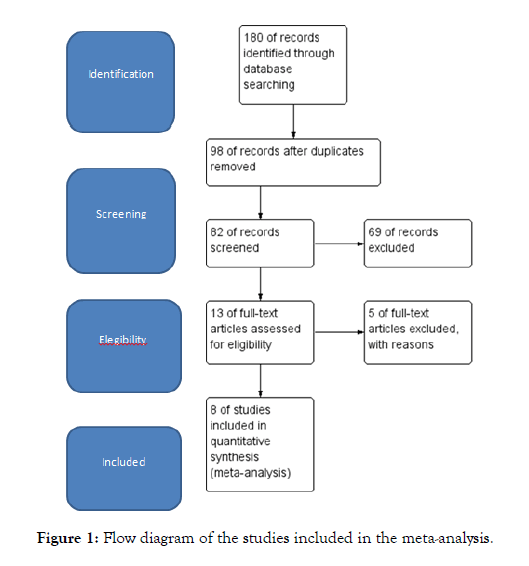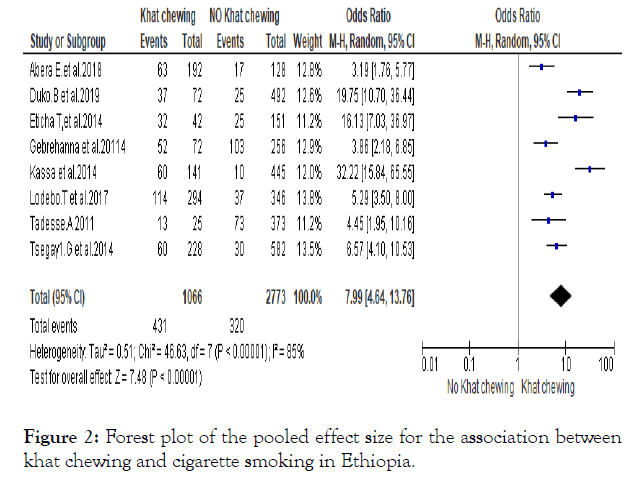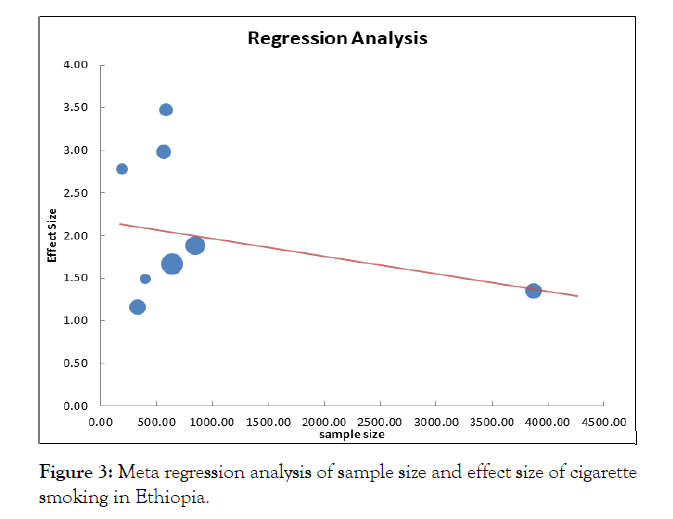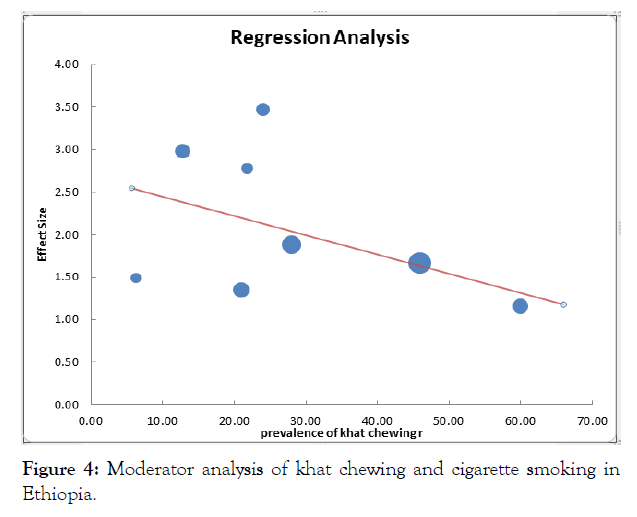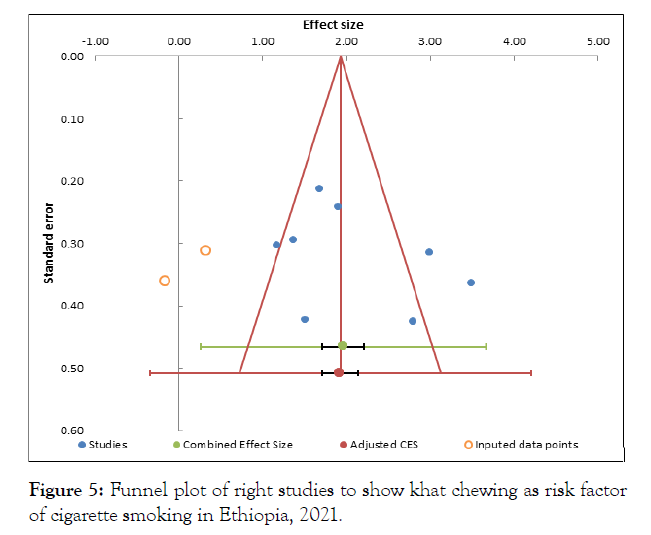Indexed In
- Open J Gate
- Academic Keys
- ResearchBible
- China National Knowledge Infrastructure (CNKI)
- Centre for Agriculture and Biosciences International (CABI)
- RefSeek
- Hamdard University
- EBSCO A-Z
- OCLC- WorldCat
- CABI full text
- Publons
- Geneva Foundation for Medical Education and Research
- Google Scholar
Useful Links
Share This Page
Journal Flyer

Open Access Journals
- Agri and Aquaculture
- Biochemistry
- Bioinformatics & Systems Biology
- Business & Management
- Chemistry
- Clinical Sciences
- Engineering
- Food & Nutrition
- General Science
- Genetics & Molecular Biology
- Immunology & Microbiology
- Medical Sciences
- Neuroscience & Psychology
- Nursing & Health Care
- Pharmaceutical Sciences
Review Article - (2021) Volume 9, Issue 3
Khat Chewing as a Risk Factor of Cigarette Smoking in Ethiopia Systemic Review and Meta-Analysis
Wosenyeleh Semeon Bagajjo1, Kaleab Tesfaye Tegegne2*, Demelash Zeleke3, Andualem Zenebe2 and Abiyu Ayalew Assefa22Department of Public Health, Hawassa College of Health Science, Hawassa, Ethiopia
3Department of Nursing , Hawassa College of Health Science, Hawassa, Ethiopia
Received: 02-Mar-2021 Published: 31-Mar-2021, DOI: 10.35248/2329-891X.21.9.276
Abstract
Background: Tobacco use is a major public health issue and strongest lifestyle related with increase probability of Cardiovascular Disease (CVDs), the objective of this systemic review and meta-analysis was to determine whether khat chewing is risk factor of cigarette smoking In Ethiopia.
Methods: Eligible studies were identified by searching different databases like PubMed, Google Scholar and Web of science for published and unpublished articles; Data were extracted from the eligible studies using data abstraction form by two independent authors. Publication bias was assessed using the visual funnel plot and Egger’s test. Meta-analysis was performed by using random-effects models with the Der Simonian and Laird method.
Results: Eight studies were found to be eligible and included in the meta–analysis. Out of 3839 respondents 751(19.56%) were cigarette smokers. The proportion of cigarettes smoking among khat chewers and non khat chewers were 40.43% and 11.54% respectively. The final pooled effect size after trim and fill was found to be 1.93 (95%CI: 1.71, 2.14). This showed the presence of a significant association between khat chewing and cigarettes smoking.
Conclusions: Khat chewing were found to be significantly associated with cigarette smoking therefore, effective khat chewing prevention and intervention programs are required to reduce smoking among People in Ethiopia.
Keywords
Khat chewing; Meta-analysis; Cigarette smoking; Systematic Reviews.
Introduction
Tobacco use is a major public health issue and strongest lifestyle related with increase probability of Cardiovascular Disease (CVDs) [1]. Globally, nearly a third of the world’s population greater than aged 15 years is smokers [2].
The prevalence continues to rise in developing countries [3]. Nearly 80% of smokers worldwide live in low- and middle-income countries [4].
It was found that khat chewing were significantly associated with cigarette smoking in studies done in Northern Ethiopia [5] and in Addis Ababa [6].
Previous systemic review done on Epidemiology of Tobacco use among Khat Users recommends further research to be done on the level of tobacco use among khat users and khat non users to develop prevention activities by identifying at risk population [7].
There are no studies done in Ethiopia on the association between khat chewing and cigarette smoking.
The study will give useful data by evaluating evidence on the association of khat chewing and cigarete smoking, thus help for general smoking cessation interventions and fill evidence gaps by identifying at risk of smoking population.
The objective of this systemic review and meta-analysis was to determine whether khat chewing is risk factor of cigarette smoking In Ethiopia.
Methods
Reporting and search strategy
The reviewers done this systematic review and meta-analysis using preferred reporting items for systematic review and meta-analysis [8]. Eligible studies were identified by searching different databases like PubMed, Google Scholar and Web of science for published and unpublished articles.
Selection of studies
All studies were searched and after that duplicated studies were removed.
The title and abstract of 82 of articles screened were assessed independently by two reviewers.
Disagreements were resolved by discussion.
Eligibility criteria
• Reviewers were selected studies published from 2011 to 2019 according inclusion criteria
• The article must have included the frequency of smoking status among khat users and khat non users in the multivariable logistics regression table and must be done in Ethiopian
Studies other than English language were excluded from review.
For the association between khat chewing and smoking status, odds ratio, 95% confidence interval, and p value were used.
Outcome measure
Smoking status was dichotomized into non-smokers who did not smoke during their life time and coded “0” (who had never tried a cigarette in his/her lifetime) and smokers who smoked during their life time (intermittent and regular smokers combined and coded “1”) (current and former smoker).
Study design: Observational studies (cross-sectional and cohort/ longitudinal) were included.
Data extraction: Data were extracted from the eligible studies using data abstraction form by two independent authors The extracted data include the name of the first author, region, year of publication, study design, sample size, number of smokers and number of khat chewers.
Quality assessment: Four authors appraised the quality of each included study using a Joanna Briggs Institute’s critical appraisal tool for analytical cross-sectional studies.
The JBI has eight components needed to qualify:
• Clearly defined inclusion in the sample
• Study subjects and the setting described in detail
• Exposure measured in a valid and reliable way
• Objective, standard criteria used for measurement of the condition
• Identified confounding factors
• Strategies to deal with confounding factors stated
• Outcomes measured in a valid and reliable way
• Appropriate statistical analysis used
Studies which fulfill all eight components were included [9,10] (Table 1).
Table 1: Characteristics of 8 studies reporting cigarette smoking among khat chewers and non khat users in Ethiopian included in systematic review and meta-analysis of 2021.
| Author | Year of Publication |
Design | Sample Size |
Prevalence smoking (%) |
|---|---|---|---|---|
| Eticha T, et al. | 2014 | Cross Sectional |
193 | 29.5 |
| Duko. B, et al. | 2019 | Cross Sectional |
564 | 11 |
| Tadesse. A | 2011 | Cross sectional |
398 | 21.6 |
| Lodebo. T, et al. | 2017 | Cross sectional |
640 | 23.6 |
| Kassa et al. | 2014 | Cross Sectional |
586 | 11.9 |
| Gebrehanna, et al. | 2014 | Cross Sectional |
3872 | 4 |
| Tsegay1.G, et al. | 2014 | Cross Sectional |
845 | 10 |
| Abera E, et al. | 2018 | Cross sectional |
333 | 24 |
Data synthesis and statistical analysis
The extracted data from the eligible studies were entered into a Microsoft Excel Database and were converted to event/total and entered into RevMan software version 5.1 for analysis. Metaanalysis was performed by using random-effects models with the DerSimonian and Laird method. The extent of heterogeneity between studies was measured by the index of the heterogeneity (I2 statistics) test. I2 values of 25%, 50%, and 75% was used as low, medium, and high heterogeneity, respectively (Figures 1 and 2).
Figure 1: Flow diagram of the studies included in the meta-analysis.
Figure 2: Forest plot of the pooled effect size for the association between khat chewing and cigarette smoking in Ethiopia.
Source of heterogeneity
According to the Meta regression analysis in the random effect model, sample size and effect size showed significant difference (B=0.00, p-value <0.028) (Figure 3).
Figure 3: Meta regression analysis of sample size and effect size of cigarette smoking in Ethiopia.
Moderator analysis was done using prevalence of khat chewing as moderator to know source of heterogeneity. Publication bias was assessed using the visual funnel plot and Egger’s test. p value <0.05 was considered as statistically significant publication bias.
Moderator analysis
We assess interactions between risk of cigarete smoking in khat chewer’s vs non khat chewers, as expressed with odds ratios and a moderator or covariate of interest is prevalence of khat chewing in each study.
Accordingly, the moderator analysis indicated that as prevalence of khat chewing increase the effect size of cigarettes smoking increases (B=-0.02, p-value <0.001) (Figure 4).
Figure 4: Moderator analysis of khat chewing and cigarette smoking in Ethiopia.
Results
Description
All records identified through database searching were published. Out of 180 studies, 8 were considered for analysis. The researchers excluded 172 studies using PRISMA 2009 Flow Diagram [8] (Figure 1).
Study characteristics: In this study, a total of 3839 study participants were included from 8 studies. All of the studies included were cross-sectional with a sample size ranging from 193 to 3972 (Table 1). Based on the JBI, all the included studies had no methodological defect.
Prevalence of cigarette smoking
Out of 3839 respondents 751(19.56%) were cigarette smokers.
The proportion of cigarettes smoking among khat chewers and non khat chewers were 40.43% and 11.54% respectively.
Meta-analysis
From the pooled effect size of eight studies, those who had history of khat chewing were 7.99 times more likely to smoke cigarettes as compared to non khat chewers 7.99 (95% CI: 4.64-13.76; I2 82% )
Assessment of reporting biases
Thus, the results of the test suggested no existence of a significant publication bias (p=0.320) in Egger’s test but the funnel plot was asymmetric and Eggers test showed there is change in the trim and fill analysis.
Because of this, we have done trim and fill analysis to adjust the final pooled effect size. This method indicated that two studies are missing on the left side of the mean size based on random effect model.
So the final pooled effect size after trim and fill was found to be 1.93 (95% CI: 1.71, 2.14). This showed the presence of a significant association between khat chewing and cigarettes smoking (Figure 5).
Figure 5: Funnel plot of right studies to show khat chewing as risk factor of cigarette smoking in Ethiopia, 2021.
Discussion
The purpose of this systematic review and meta-analysis was to estimate the pooled effect size for the association between khat chewing and cigarette smoking in Ethiopia. The final pooled effect size after trim and fill was found to be 1.93 (95% CI: 1.71, 2.14). The odds of cigarette smoking are 1.93 times higher among khat chewers compared to those who do not chew khat.
Our findings are comparable with a study in Zimbabwe [11], China [12], India [13], Axum Town, North Ethiopia [14], Dire-dawa University, Eastern Ethiopia [15], Jigjiga University [16], Halaba Kulito town, Southern Ethiopia [17], Bahir Dar Town, Ethiopia [18], Ethiopian University Students A Systematic Review and Meta-Analysis [19] and Addis Ababa University in Ethiopia [20].
This may be because cigarettes and khat are commonly interrelated. This might be true due to the high relationship between Khat and smoking. Starting with one substance might initiate the use of combined substances. Since most khat chewers use cigarette to enhance their level of excitement, the proportion of smokers observed among khat chewers were high. Tobacco use is embedded within the culture of khat chewing [21]. The habit of tobacco use among khat users is substantial [7]. These study findings were inconsistence with a study on university Students in Ethiopia which states no association between khat chewing and cigarettes smoking [22]. The explanation for this difference may be difference in sample size, study characteristics and variation in prevalence of khat chewing.
Conclusion
Khat chewing was found to be significantly associated with cigarette smoking. Therefore, effective khat chewing prevention and intervention programs are required to reduce smoking among People in Ethiopia.
Data Availability
All data are included in the paper.
Author's Contributions
Kaleab Tesfaye Tegegne was responsible for conceptualization, project administration, software, supervision, and development of the original drafting of the manuscript.
Kaleab Tesfaye Tegegne, Andualem Zenebe, Demelash Zeleke, Abiyu Ayalew Assefa, and Wosenyeleh Semeon Bagajjo were participated in quality assessment of articles, methodology, validation, and screening of research papers.
All authors contributed with data analysis, critically revised the paper, and agreed to be accountable for their contribution.
Competing of interests
The authors have declared that there is no competing interest.
Acknowledgement
We would like to thank all the primary authors of the included articles.
REFERENCES
- World Health Organization (2013) World No Tobacco Day. Geneva, Switzerland.
- Fawibe AE, Shittu AO. Prevalence and characteristics of cigarette smokers among undergraduates of the University of Ilorin, Nigeria. Niger J Clin Pract. 2011;14(2):201-205.
- Yahya SJ, Hammangabdo A, Omotara BA. Factors influencing the onset of cigarette smoking among adolescents in Konduga local government area. Niger J Med. 2010;19(3):275-278.
- World Health Organization. Tobacco. http://www.who. int/news-room/fact-sheets/detail/tobacco. Accessed June 4, 2019.
- Eticha T, Kidane F. The prevalence of and factors associated with current smoking among college of health sciences students, mekelle university in northern ethiopia. PLoS ONE. 2014;9(10):e111033.
- Deressa W, Azazh A. Substance use and its predictors among undergraduate medical students of Addis Ababa University in Ethiopia. BMC Public Health. 2011;11:660.
- Kassim S, Jawad M, Croucher R, Akl EA. The epidemiology of tobacco use among khat users: a systematic review. Biomed Res Int. 2015;2015:313692.
- Moher D, Shamseer L, Clarke M, Ghersi D, Liberati A, Petticrew M, et al., Preferred reporting items for systematic review and meta-analysis protocols (PRISMA-P) 2015 statement. Syst Rev. 2015;4(1):1.
- Moola S, Munn Z, Tufanaru C, Aromataris E, Sears K, Sfetc R, et al., Chapter 7: systematic reviews of etiology and risk. Joanna Briggs Institute Reviewer’s Manual.
- Liu JL. The role of the funnel plot in detecting publication and related biases in meta-analysis. Evid Based Dent. 2011;12(4):121-122.
- Bandason T, Rusakaniko S. Prevalence and associated factors of smoking among secondary school students in Harare Zimbabwe. Tob Induc Dis. 2010;8(1):12.
- Wang M, Zhong JM, Fang L, Wang H. Prevalence and associated factors of smoking in middle and high school students: a school-based cross-sectional study in Zhejiang Province, China. BMJ Open. 2016;6(1):e010379.
- Kumar R, Salve H, Misra P. Determinants of tobacco use and perception, attitude about an ant tobacco act in rural Haryana, North India. Int J Med Public Health. 2014;4:367-370.
- Gebreslassie M, Feleke A, Melese T. Psychoactive substances use and associated factors among Axum University students, Axum Town, North Ethiopia. BMC Public Health. 2013;13:693.
- Kumburi TG, Gelgile AK, Hatehu BT, Gemechu DT. Psycho-active substances use and determining factors among regular undergraduate students of dire-dawa university, eastern Ethiopia. Sci J Public Heal. 2017;5(2):68-76.
- Banti TK, Mengesh DS, Mamade GF. Prevalence of cigarette smoking and factors associated with it among undergraduate students of jigjiga university. Inter J Psycho Brain Sci. 2017;2(3):87-91.
- Ketema T, Alemayehu E, Ambelu A. Exploration of pattern of use of khat and tobacco among residents of Halaba Kulito town, southern Ethiopia. J Biol Chem Res. 2015;32:374-386.
- Mulugeta Y. Khat Chewing and its associated Factors among College Students in Bahir Dar Town, Ethiopia. Sci J Public Health. 2013;1(5):209-214.
- Guracho YD, Addis GS, Tafere SM, Huris K, Bifftu BB, Goedert MH, et al. Prevalence and factors associated with current cigarette smoking among ethiopian university students: a systematic review and meta-analysis. J Addiction. 2020;9483164:10.
- Deressa W, Azazh A. Substance use and its predictors among undergraduate medical students of Addis Ababa University in Ethiopia. BMC Public Health. 2011;11:660.
- Nichter M. Smoking: what does culture have to do with it? Addiction. 2003;1:139-145.
- Gebrehanna E, Berhane Y, Worku A. Prevalence and Predictors of armful Khat se mong niversity Students in Ethiopia. Substance Abuse: Research and Treatment. 2014:8:45-51.
Citation: Bagajjo WS, Tegegne KT, Zeleke D, Zenebe A, Assefa AA (2021) Khat Chewing as a Risk Factor of Cigarete Smoking in Ethiopia Systemic Review and Meta-Analysis. J Trop Dis. 9:276
Copyright: © 2021 Bagajjo WS, et al. This is an open-access article distributed under the terms of the Creative Commons Attribution License, which permits unrestricted use, distribution, and reproduction in any medium, provided the original author and source are credited.


